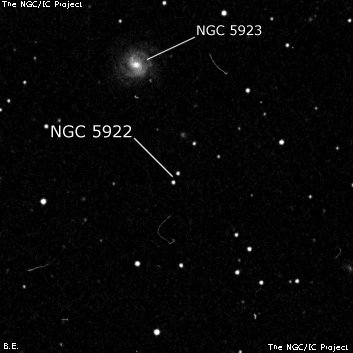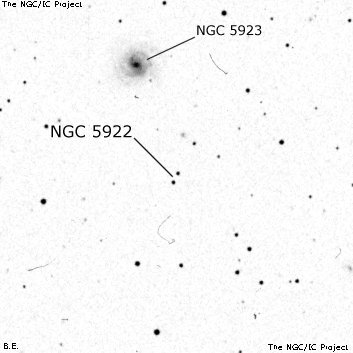NGC/IC Project Restoration Effort
(This is a very very beta version)
NGC5922


Basic Information
Location and Magnitude
Right Ascension: 15:21:14.1
Declination: +41:43:35
Constellation: BOO
Visual Magnitude: 13.1
Historic Information
Discoverer: Herschel W.
Year of discovery: 1787
Discovery aperture: 18.7
Observational
Summary description: eF, S
Sub-type: SBbc
Corwin's Notes
=====
NGC 5922 is almost certainly NGC 5923. I had this as a double star for many
years following the NGC position which comes from WH. This position is about
an arcminute southwest of the wide double, and WH says only "eF, S" on 9 April
1787, where it was the last object in a very productive sweep (No. 725).
However, I have just noticed (October 2015) that NGC 5923 does not have a WH
number in the NGC. JH is credited as the discoverer -- he recorded it in four
different sweeps -- and calls it "vF, R, vgbM, 40[arcsec]", "eF, L, R,
60[arcsec]", and "F, pL, lE, vgbM", with "No description" on the fourth night.
Though he makes the size larger, his brightness estimates are not wildly
inconsistent with his father's. The galaxy has relatively low-surface-
brightness arms, so it is possible that WH saw just the inner region. This
might account for the "S" size that he recorded.
WH's observations let us derive three different positions, one by simply
precessing CH's reduced position (using the 1800 position for HD 128902 which
WH calls "244 (B) Bootis of Bode's Cat."), the second by reducing the offsets
given in the sweep (43min 31sec following and 2deg 9arcmin south of the star),
and a third by reducing the offsets that WH published in his second list of
nebulae (these are given relative to the star 20 CVn). All are accordant
within WH's usual errors of 2-3 arcminutes, with a mean position about five
arcminutes south of the galaxy.
JH claims to have seen it, too (also on just a single night, 6 May 1828), but
has even less data: "No descr. RA by working list; PD rough." In the sweep,
"III 661" is No. 41 and the wire column has a notation that I haven't
deciphered yet. The clock reading is "15 18 40" with the chronometer beat at
"-9" and the NPD index is "2 43 00"; there is no description. JH's reduced
position is "[15 15 43]", "47 44 48::", obviously uncertain. There is nothing
at all in that position.
The nearest star in JH's sweep is beta Boo at "14 56 40", "-15", wire 2, "3 54
55". Assuming the same wire was used for "III 661", then the position becomes
15 23 25, +41 35.5 (J2000). If wire 1, then the RA is 15 22 42; if the edge
of the field, then the RA becomes 15 24 03. There is nothing at any of these
positions that JH might have glimpsed, so his "sighting" must have been based
on his expectation of seeing something in his father's place and not much
else.
What about NGC 5923? It is No. 40 in the sweep, and is noted at "15 16 15",
"-14", wire 2, "2 38 20", about 2.5 minutes preceding No. 41, and nearly five
arcminutes north. JH's reduced position is "15 15 10.3", "47 40 08"; this
precesses to 15 21 17, +41 43.0 for J2000, which is within an arcminute of the
modern position. Taking the difference and assuming the same wire for the
"III 661" data, the offset leads us to a faint double star at 15 23 42.3
+41 38 40 (J2000). Is this the object that JH took for H III 661? (Assuming
either wire 1 or the edge of the field leads to empty fields.) The fact that
JH put so little effort into the object suggests that he had little confidence
in his observation. On the other hand, he put the object in both of his
catalogues (his 1833 list, and the GC of 31 years later), so Dreyer followed
suit for the NGC.
In short, it is difficult to understand how WH might have mistaken a faint,
wide double star as a nebula while passing over a much brighter galaxy just a
few arcminutes to the north. And JH's observation of an object somewhere near
his father's position has almost certainly no basis beyond his desire to find
a faint nebula there.
So, while the equality of NGC 5922 with NGC 5923 is not assured by the data, I
am nevertheless certain enough about it to list it with colons in the big
table.
Steve's Notes
=====
NGC 5922
See observation of NGC 5923.



